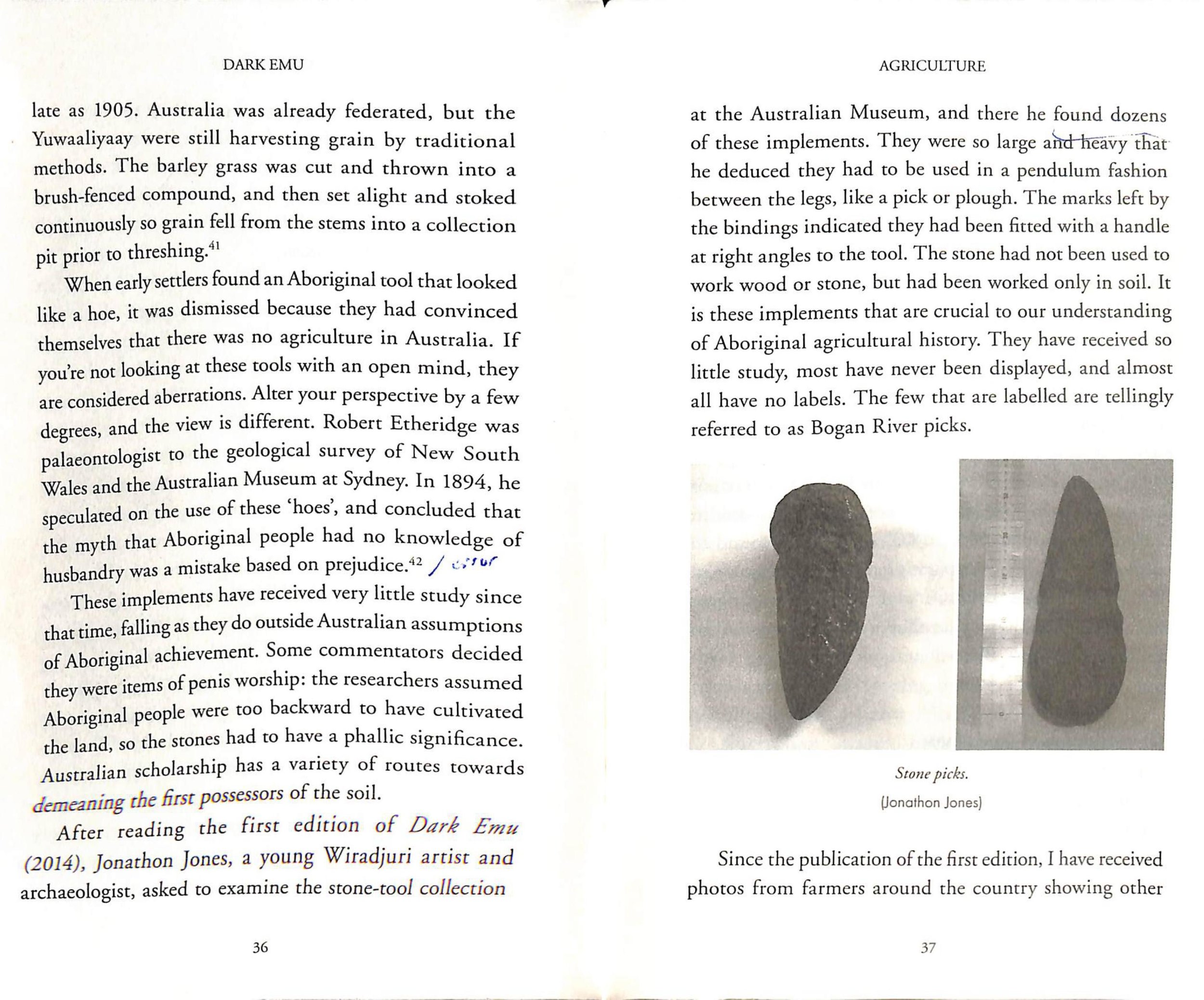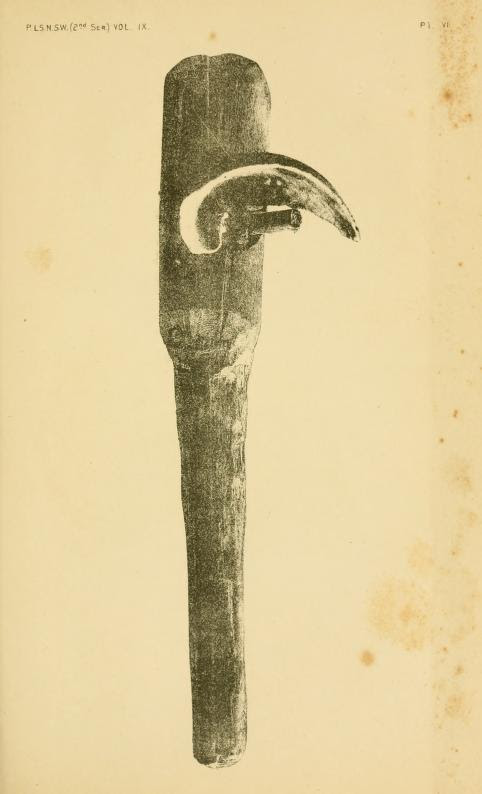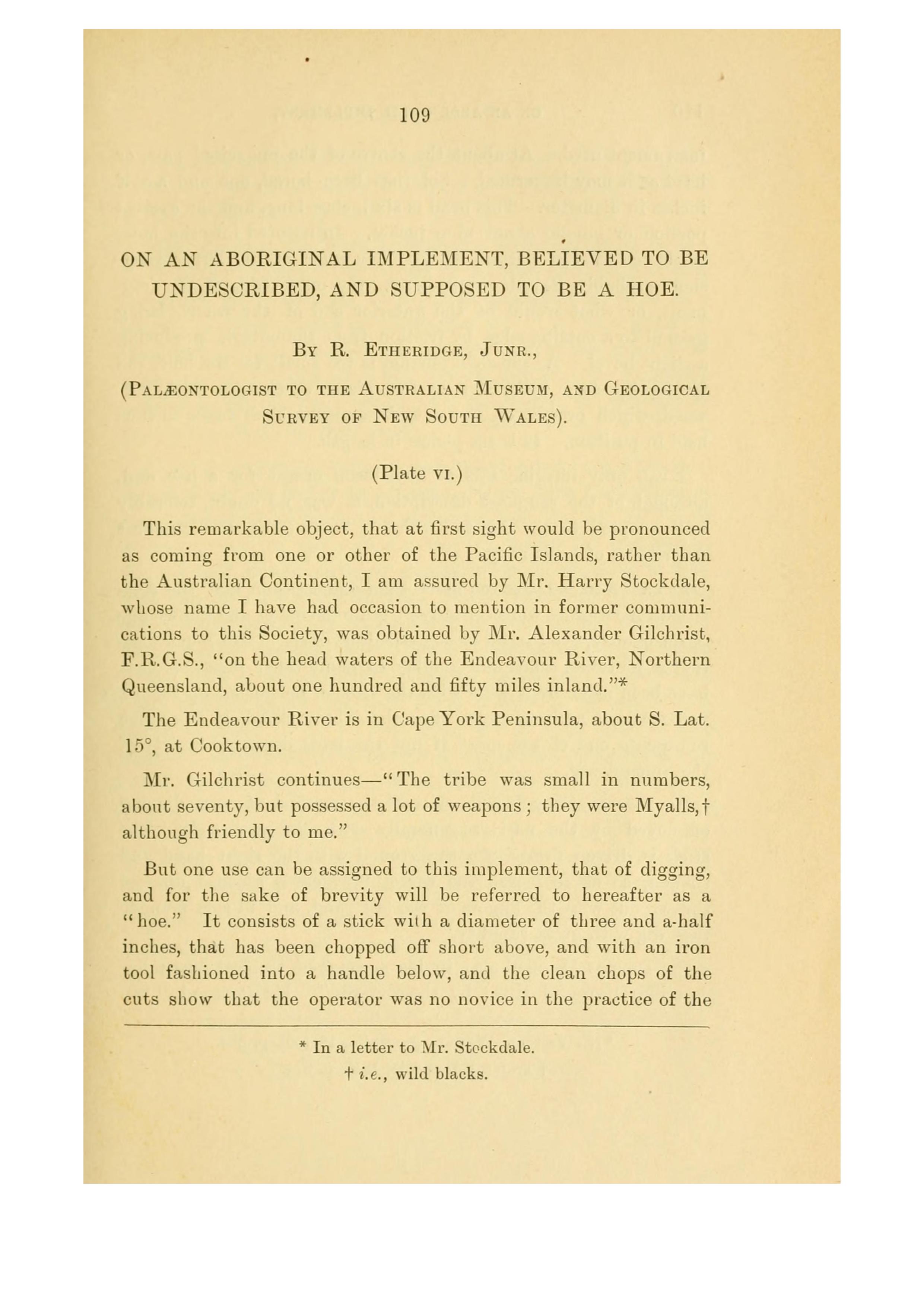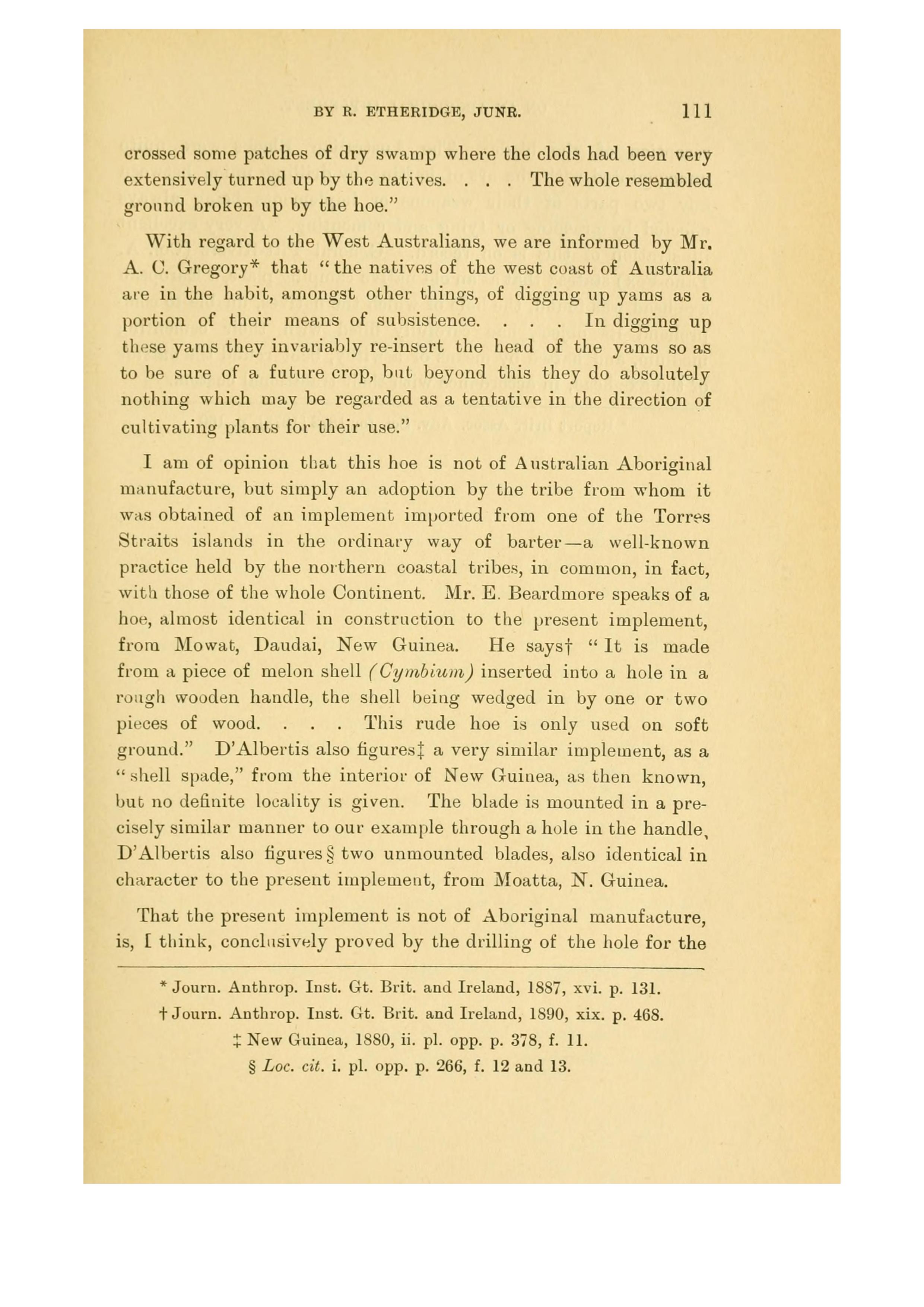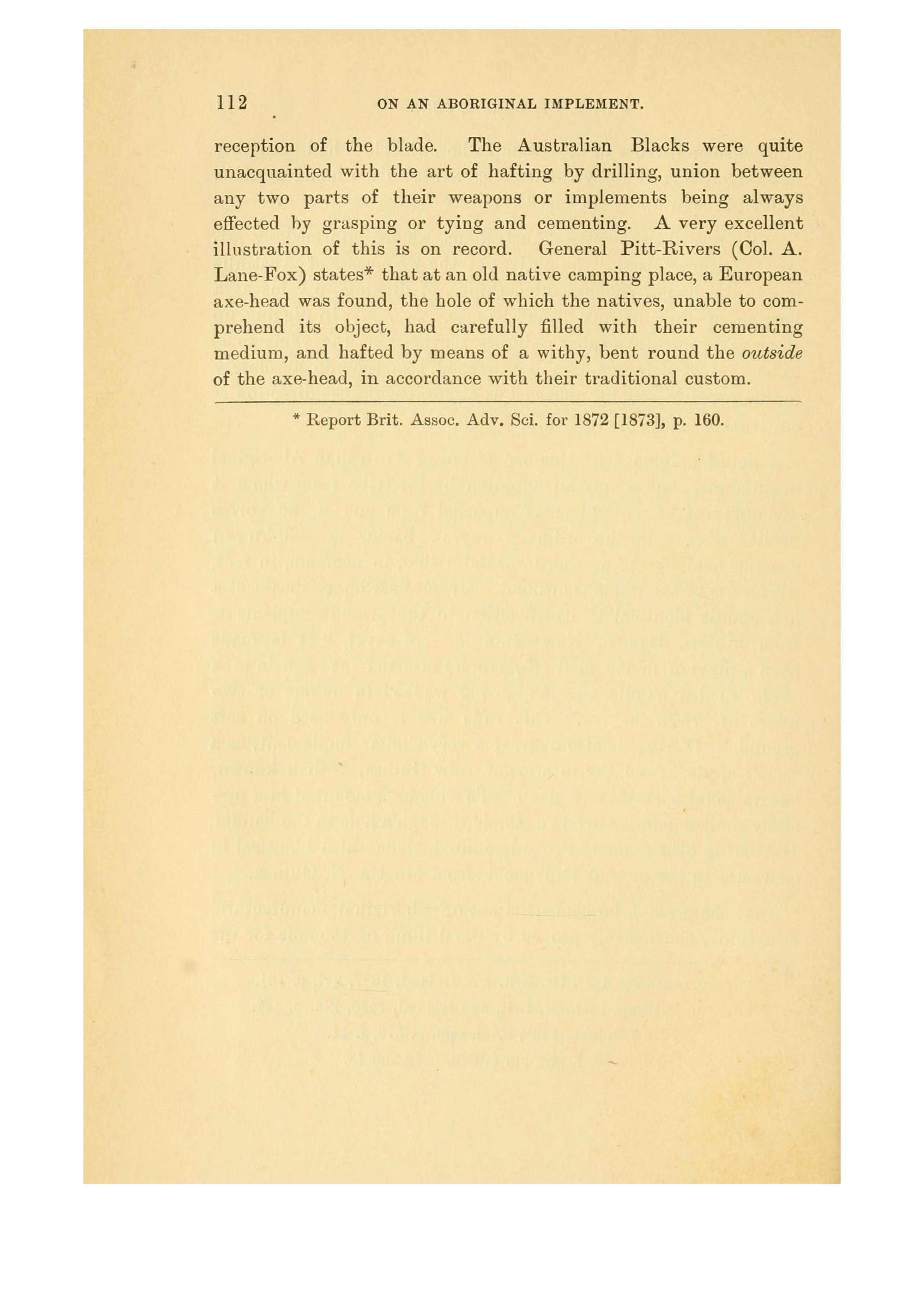Bogan Picks and the Case of the Missing Hoe
To support his ‘Aboriginal Agriculture’ theory, Mr Pascoe needs some ‘farm machinery’, and he has identified the stone tools known as ‘Bogan picks’ as the tilling implements that the Aboriginal ‘farmers’ used to ‘hoe’ the land when cultivating their ‘vast crops’ (Dark Emu, 2018 reprint, p36-37).
Mr Pascoe strikes ideological gold to support his theory in the name of one, Robert Etheridge. From Dark Emu we learn :
“ Robert Etheridge was a palaeontologist to the geological survey of New South Wales and the Australian Museum at Sydney. In 1894, he speculated on the use of these ‘hoes’, and concluded that the myth that Aboriginal people had no knowledge of husbandry was a mistake based on prejudice (Dark Emu’s Ref 42, Etheridge 1894, p.110, in Gerritsen, 2008 p.110 - [actually we found it on p.62, Ed]).”
So, not only does it appear that Mr Pascoe has found a reference to an Aboriginal ‘hoe’, but he also relies on this reference to add another anti-colonial quote about the early settlers being prejudiced and spreading myths about the low skills of the Aboriginal people.
Well, as usual with Mr Pascoe, not so fast buster. On checking Mr Pascoe’s cited “evidence”, we actually found that Robert Etheridge recorded that his ‘hoe’ is not made of stone, but is rather made from wood and shell! And it had been fashioned using an iron-tool! Etheridge states that he does not believe it to be of Australian Aboriginal origin at all, but instead has Pacific Island characteristics and probably came from the Torres Strait!!
Mr Pascoe is claiming Etheridge’s work as ‘evidence’ for his case, but in reality Etheridge’s 1894 paper provides no support at all to Mr Pascoe’s theory that stone ‘Bogan picks’ were used as ‘hoes’ to till the soil in pre-colonial Aboriginal agricultural society.
Similarly, we found that Etheridge’s 1894 paper itself misquotes Sir Thomas Mitchell’s journal with regard to the apparent use of ‘hoes’ by the Aborigines. Etheridge on pages 110-111 writes:
“Sir Thomas Mitchell also, in his account of tropical Australia describes ‘ground tilled by the natives.’ He states : ‘crossed some patches of dry swamp where the clods had been very extensively turned up by the natives…The whole resembled ground broken up by the hoe.”
On checking what Sir Thomas Mitchell actually wrote in his journal we found :
Chapter VI : “Tilled ground of the natives”…”We crossed some patches of dry swamp where the clods had been very extensively turned up by the natives, but for what purpose Yuranigh [Mitchell’s Aboriginal guide] could not form any conjecture. These clods were so very large and hard that we were obliged to throw them aside, and clear a way for the carts to pass. The whole resembled ground broken up by the hoe, the naked surface having been previously so cracked by drought as to render this upturning possible without a hoe. There might be about two acres in the patch we crossed, and we perceived at a distance, other portions of the ground in a similar state.”
So, Mitchell is saying here that, although the upturned clods resembled ground that had been broken up with a hoe, no hoe was used, as the drought had left deep cracks that made it possible for the natives to turn the clods without a hoe and presumably by hand, or with a digging stick. It may have been possible the natives were looking for yams, roots or even frogs buried in the mud under the clods.
We find it very disappointing when modern writers, such as Mr Pascoe, present a theory that they say is based on colonial references that “Australians hold to be true”, but is in fact, at complete odds with these original references. Whether this is due to poor scholarship or design, we will let the reader draw their own conclusions after reading the excerpt from Dark Emu below and then comparing it to the actual Etheridge reference that Mr Pascoe quotes himself, as well as an excerpt from Sir Thomas Mitchell’s journal.
Excerpt from Dark Emu regarding Etheridge’s stone picks.
Plate 6 - Actual “hoe” from Etheridge’s 1894 paper showing wooden handle fashioned using an iron-tool, based on the cut marks, and the shell hoe-head (No stone Bogan pick here).
Page 109 of Etheridge’s paper - it has the word “HOE” in the title, which Mr Pascoe seizes on, and by placing the term “hoe” next to an unrelated picture of two stone Bogan picks in Dark Emu, he relies on the reader’s imagination to connect the two, and voila!! - we convince ourselves we are looking at the “archaeological evidence” of Aboriginal ‘hoes’ used in Agriculture.
Page 11 of Etheridge’s paper clearly says this ‘hoe” is NOT of Australian Aboriginal origin, but has instead been traded down from the Torres Strait - Some may call this a case of “cultural appropriation” by Mr Pascoe.
Etheridge’s 1894 paper misquoting Sir Thomas Mitchell
Etheridge : “Sir Thomas Mitchell also, in his account of tropical Australia describes ‘ground tilled by the natives.’ He states : ‘crossed some patches of dry swamp where the clods had been very extensively turned up by the natives…The whole resembled ground broken up by the hoe.”
Mitchell : “crossed some patches of dry swamp where the clods had been very extensively turned up by the natives…The whole resembled ground broken up by the hoe, the naked surface having been previously so cracked by drought as to render this upturning possible without a hoe. There might be about two acres in the patch we crossed, and we perceived at a distance, other portions of the ground in a similar state.
Click here for : Mitchell’s Journal








